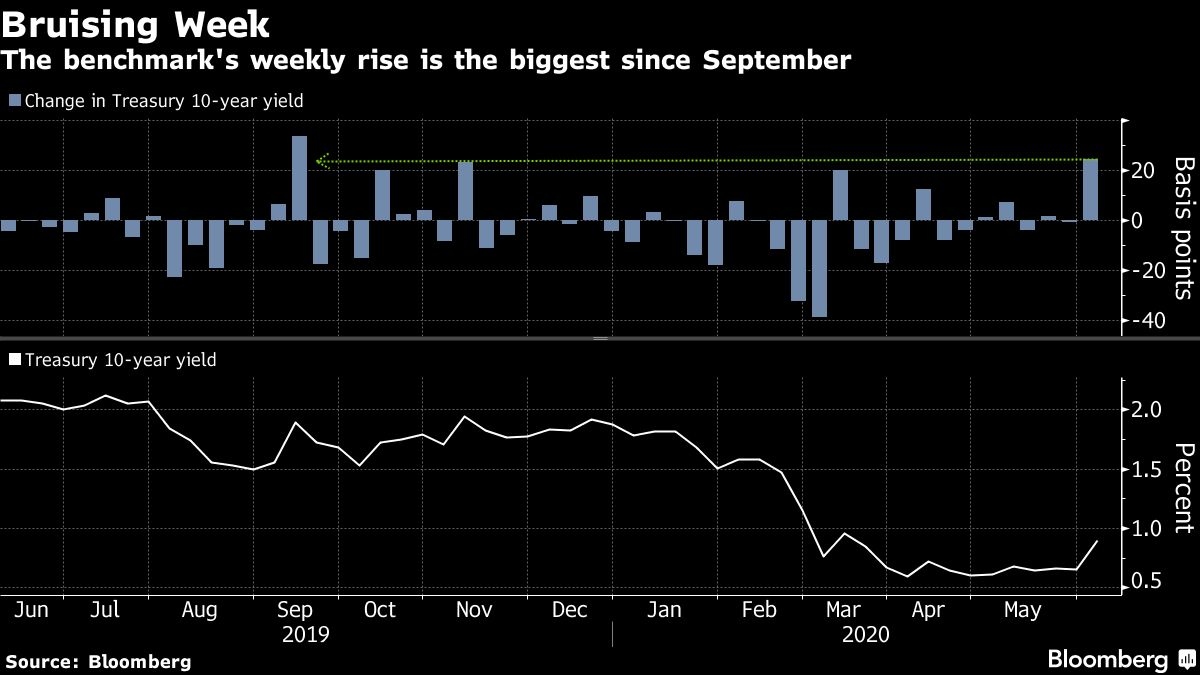Jun 7, 2020
Bond market's bears are on a tear, but Fed to have its say
, Bloomberg News
Larry Berman: Bond market sending different messages than the stock market
The pandemic’s grip on U.S. Treasuries has loosened, allowing yields to take flight. The Federal Reserve’s next move will show just how far they can soar.
The world’s haven market is coming off its roughest week since September on signs the economy is fighting its way back to health. The 10-year yield broke free of the quarter-point range it’s plied for weeks, and approached one per cent on Friday’s data showing an unexpected rebound in U.S. employment. With long maturities absorbing the brunt of the losses, the yield curve is the steepest in more than three years.
It’s unlikely to be an unfettered rise from here. The Fed will probably welcome all signs of recovery in its statement at the conclusion of this week’s meeting. But policy-makers may be wary of an unruly increase in borrowing costs that could add to strains on businesses and households, and raise the price tag of the government’s rescue efforts.

“The sheer cost of debt from all the stimulus put in place needs to be managed,” said Paul Brain, a fixed-income portfolio manager at Newton Investment Management.
Brain offloaded some Treasuries at the end of May — he expected the market to weaken as investors grew more confident that the economy was past the worst effects of the lockdowns. But he’s looking to buy the 10-year above one per cent. That’s “cheap insurance,” he says, against the myriad risks to a broad-based recovery, such as a second wave of the virus, renewed closings and a surge of corporate defaults.
The world’s benchmark rate peaked at 0.96 per cent on Friday, and rose 24 basis points on the week, the most since September.
The first big test of where the market sees fair value for government debt this week comes with the auctions of three- and 10-year notes, Monday and Tuesday. The last round in May went smoothly despite record-low yields, and the latest selloff could help demand this time around. The Treasury sells 30-year bonds Thursday.
But the market outlook will depend to a large extent on what Fed Chairman Jerome Powell says next. He’s widely expected to reaffirm a commitment to keep rates at zero. But investors have been calling for more guidance from policy-makers on the central bank’s plans for asset purchases — which it reduced again Friday to a daily total of US$4 billion, compared with US$75 billion at the height of the crisis in March.
The Fed is expected to formalize a transition from its emergency measures to stabilize markets to a longer-term strategy to support the economic recovery. For many, that would involve a form of yield-curve control.
A slim majority of economists in a Bloomberg survey say they see the Federal Open Market Committee setting specific targets for yields — similar to policies in Japan and more recently Australia — before the year is out. Of those predicting that step, most said the announcement would likely come in September.
What to Watch
Here’s the economic calendar:
• June 9: NFIB small business optimism; JOLTS job openings; wholesale inventories/trade sales
• June 10: MBA mortgage applications; consumer price index; real average earnings; monthly budget statement
• June 11: Producer price index; jobless claims; Bloomberg consumer comfort
• June 12: Import/export price index; Bloomberg June U.S. economic survey; University of Michigan survey; household change in net worth
• The FOMC will release its policy statement June 10, after which Powell holds a press conferen
The auction calendar:
• June 8: 13-, 26-week bills; three-year notes
• June 9: US$40 billion 119-day cash-management bill; US$60 billion 42-day cash-management bill; 10-year note reopening
• June 11: four-, eight-week bills; 30-year bonds








